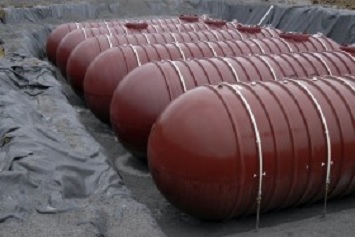Nassau County in New York recently settled 48 counts of violations related to underground storage tank (UST) regulations in a civil matter filed by the EPA in the U.S. District Court for the Eastern District of New York. As part of the agreement, Nassau must “install equipment to [ensure] adequate leak detection across all county facilities,” including adding a centralized monitoring system, according to justice.gov. “The settlement also requires Nassau to pay a civil penalty of $427,500.”
 UST regulations fall under the Resource Conversation and Recovery Act (RCRA) of 1976. These detailed regulations are often a source of confusion, as Nassau County has discovered.
UST regulations fall under the Resource Conversation and Recovery Act (RCRA) of 1976. These detailed regulations are often a source of confusion, as Nassau County has discovered.
“Nassau County and EPA have worked out an agreement that will help ensure that underground storage tanks (USTs) will be properly monitored and regulated to protect human health and the environment,” said EPA Regional Administrator Peter Lopez.
History of This Case
Before this lawsuit, the EPA filed a complaint that alleged Nassau County had a recurring issue with failing to comply with UST safety requirements at 33 facilities from 2008 to 2010. “The EPA and Nassau reached a settlement of these claims in a September 2012 administrative Consent Agreement and Final Order (CA/FO),” according to justice.gov. “However, Nassau failed to complete the injunctive work requirements in the CA/FO, leading to this judicial action.
“Further, after entering into the CA/FO, from 2012 to 2017, Nassau continued to violate the UST regulations.
“Specifically, it did not:
- conduct pipe tightness testing at 12 facilities,
- upgrade or close a steel UST at one facility,
- add secondary containment (or permanently close) the hazardous substance USTs at two facilities,
- install release detection equipment for the USTs at 17 facilities,
- install release detection equipment for the USTs at 11 emergency generator facilities,
- install overfill prevention equipment for the USTs at 12 facilities, and
- permanently close a UST that had been temporarily closed.”
The county said there were never any leaks detected in its equipment, and soil tests have not been contamination-positive. Nassau County has now spent more than $7 million on monitoring equipment over the past several years, said Michael Fricchione, a spokesman for the county, according to newsday.com.
Understanding UST Regulations
The EPA defines a UST as any tank and connected pipes that have at least 10% of their combined volume underground. These regulations only apply to tanks storing petroleum, biofuel-blended petroleum, and certain other hazardous substances under the Comprehensive Environmental Response, Compensation, and Liability Act of 1980 (CERCLA). Hazardous wastes are regulated under Subtitle C of RCRA and are not covered by the federal UST regulations.
UST regulations were updated in 2015. The requirements are extensive and cover every detail from installation to closing USTs, so keeping up with compliance requirements and staying on schedule can be a challenge.
- Installation. Installation issues generally arise from failure to follow standard industry codes and procedures. Owners are advised to use qualified installers. New systems are required to have under-dispenser containment meeting specific guidelines, and all systems are required to have the certification on the notification form completed and signed.
- Reporting. There are several 30-day reporting requirements related to installation, notification forms, switching to certain biofuels and substances, when releases are suspected and/or confirmed, and when permanently closing a UST. Implementing agencies often have additional reporting requirements.
- Spill and overfill prevention. All tanks receiving deliveries of more than 25 gallons must meet overfill prevention requirements, including inspection and testing every 3 years. All such UST systems are required to have:
- Spill buckets
- Automatic shutoff devices or overfill alarms
- Correct filling practices
- Corrosion protection. These requirements cover the types of materials used and specific inspections and testing procedures for cathodic protection systems.
- Release detection. Release detection requirements for tanks, pressurized piping, and suction piping include monthly monitoring requirements, leak detection equipment testing, containment sump testing, and release detection testing.
- Walk-through inspections. All facilities are required to complete 30-day and annual walk-through inspections and keep records of these inspections. The EPA maintains a detailed list of what must be covered during these inspections.
- Compatibility. The materials used to line USTs must be compatible with the type of substance being stored, and operators must maintain records that demonstrate compliance with the compatibility requirement.
- Operator training. All facilities are required to have designated and trained Class A, B, and C operators.
- Repairs. UST regulations require components to be tested and inspected following repairs.
- Financial responsibility. All facilities are required to keep records demonstrating their financial ability to clean up a site if a release occurs, correct environmental damage, and compensate third parties for injury to their property or themselves.
- Release response. Specific corrective actions are regulated in the event of releases related to containing the release, preventing harm, and reporting, including a corrective action plan and approval of the actions by the implementing agency.
- Closure. The regulations contain specific steps to close a UST temporarily or permanently.
In order to stay in compliance with UST regulations and avoid enforcement actions, it is necessary that UST owners and operators have a clear understanding of the full scope of requirements applicable to their facility, especially notification, monitoring, inspection, testing, training, and reporting requirements and schedules.
For more detailed information on UST compliance, see the EPA’s “Musts for USTs” publication and BLR’s Underground Storage Tanks regulatory analysis.
